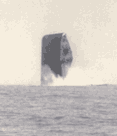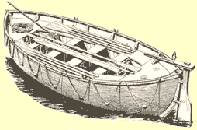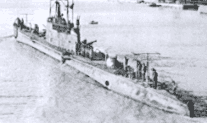The Sinking of the Esso Tanker T. C. McCobb
by Bruce Felknor
Lifeboats play a big part in the drama and tragedy of merchant mariners in World War II. When the unarmed Esso tanker T. C. McCobb went down on March 31, 1942, four hundred miles off Brazil's north coast, it set in motion a whole series of lifeboat tales of luck, death, and everything between.
Esso Tanker T. C. McCobb soon after launchingThe Chase
At 4:25 pm a few distant booms broke the routine of uneventful day in the tropics. Far astern, a submarine was running on the surface at full speed, firing deck guns at the McCobb. The six-year-old tanker stopped zig-zagging and steered into the setting sun to make a harder target. Down below, the engineers performed miracles which got her close to her certified speed of 12.7 knots. The submarine was making close to 17. After 20 shots the firing stopped, but the chase went on, and by 5:40 the sub had closed to within a mile. It resumed fire, and soon every shot was a direct hit. Captain Robert W. Overbeck ordered the engines stopped, and prepared to abandon ship. The sub ceased fire as three lifeboats got away.
Abandon Ship
A moderately heavy sea was running, and lifeboat No. 1 was released from the falls while it was still in the air. It crashed down on a battering wave and soon was hardly afloat. Shell fragments had punctured the No. 2 boat, with Capt. Overbeck aboard, but in the gathering dusk the damage was not noticed until water began rushing in. No. 3 got away safely with the second mate, William Sims, in command.As soon as the holes were patched, they went to the aid of boat No. 1, which was awash, with its passengers sitting in water and three men outside clinging to the gunwales. Sharks were so numerous it hindered the rescue.
Just after nightfall, a lookout spotted a dark shape approaching. It was the submarine, heading between boats No. 2 and No. 3. They watched as the sub put four torpedoes into the T.C. McCobb.
"She came upright with her bow sticking out of the water," Sims said later, "and stayed in that position for about 30 minutes. We saw a number of small fires aboard the tanker. By 9:15 p.m. [she] had finally slid down under the surface."
Good Luck for Lifeboat No. 3
At daybreak -- April Fools' Day -- the boats had drifted apart, and Sims set a course for the nearest land, French Guiana. They sailed for six days, maintaining discipline and spirit, volunteer crews standing two-hour watches, two men steering and one standing lookout. Second Mate Sims alternated six-hour watches with Third Mate Franklin Zahm.The sixth day, April 5, was Easter Sunday. Morale was still high in the boat, but it took a dip when an armed tanker came into view a scant three miles away. But despite the lifeboat's yellow distress flag she zig-zagged on and disappeared.
On April 8, changing sea color signaled the approach of land. A patrol plane flew by without seeing them. Then Able Seaman John J. Waksimonski spotted smoke: a ship, headed directly for them.
Hardly able to walk after a week in the boat, the men were helped aboard SS Santa Monica, a Greek ship flying the Panamanian flag, with a British master, Commander John W. Bugge, RNR. "He told us to make ourselves at home," Sims said later.
"The steward brought rum, and we all had a good stiff shot, drinking a toast of thanksgiving to our benefactors. Then came hot coffee and fresh cigarettes. Dinner followed.
"The men of the Santa Monica gave up their places so we could eat first. Our first meal in eight days! Beautiful and well prepared, it did for us what a good rain does for parched grass."
The Santa Monica put back into Paramaribo, Dutch Guiana. The lifeboat had made 630 miles in 7 days and 16 hours, an average speed of 3.4 knots. "No one was sick or injured and we had no quarrels or fighting among the boat crew," Sims noted in his final log entry. "We still had enough water, chocolate, and hardtack for several days, and about half a pound of raisins."
From Paramaribo all 15 men from Boat No. 3 were promptly and safely repatriated.
Boat 2: Relatively Easy
The 19 men in the Captain's boat also had a relatively easy time of it-- as far as the South American shore. At dusk on April 6 they sighted a light, but distress flares drew no response. Twice, U.S. Army planes circled overhead, but nothing came of their frantic waves.Due to strong unfavorable winds, they beached on an uninhabited stretch of French Guiana's coast for a night and a day. There they dug a well for fresh water, and boiled some of it to dress the injured hand of messman Roy A. Peacock.
Approaching Paramaribo they beached again near some fishermen, one of whom offered to pilot them into port for 50 guilders. Just then the Norwegian SS Marpesia appeared and took them aboard. "Captain Peter Malmstein and his crew gave us wonderful treatment," Capt. Overbeck reported.
Capt. Malmstein sent word to Paramaribo, and the Americans were met on arrival by a U.S. consular official, army ambulances, and Dutch authorities. They were hospitalized immediately on arrival on April 10, and except for the injured Peacock were moved to the local hotel on the 13th.
Eight of the nineteen were assigned to the SS Alcoa Puritan for repatriation. On May 6, on the way home, she was torpedoed and sunk in the Gulf of Mexico. The eight from the McCobb survived this sinking. They were rescued by the Coast Guard vessel Boutwell, which landed them safely at New Orleans.
Roy Peacock, with his injured hand, was discharged later from the hospital, and sent homeward on the Royal Dutch Line's SS Crijnssen, bound for New Orleans by way of British Guiana, Venezuela, and Curacâo. On June 10, three days out of Curacâo, she was torpedoed. Peacock escaped uninjured in a lifeboat.
"We floated around in a lifeboat all night," he said, "and the next morning set sail for shore. About 11 a.m. we sighted two vessels. One of them, SS Lebore, Ore Steamship Company, picked up the survivors..."
On June 14, four days after rescuing the Crijnssen survivors, the Lebore was torpedoed about 200 miles north of the Panama Canal Zone. Peacock and other survivors sailed their lifeboat all day and laid to overnight beside a small island.
Next morning natives directed them to a larger island, and while en route a U.S. Navy plane spotted them, dropped first-aid supplies, and reported their plight. A motorboat from Columbus Island towed them in. The next day Peacock and 26 other survivors boarded the USS Erie for the ride to Colon, C.Z.
On June 22, he left the Canal Zone aboard the Chilean Line's MS Coliapo, and finally reached New Orleans safely on June 29, nearly three months, six ships, 3 torpedoings, and three lifeboats after the sinking of the T.C. McCobb.
Three Men on a Raft
The two lifeboats accounted for 34 of the McCobb's crew; five crew were missing and presumed dead.While Michael Wajda, the ship's electrician, was lowering a lifeboat, a burst of shrapnel caught him on the head and ankle, knocking him unconscious and hurling him overboard. He came to on a life raft, where he was being revived by Second Assistant Engineer Mahlon R. Benton and Third Assistant Lindgren Bancroft. For ten days Wajda drifted in and out of a coma.
The two engineers took stock: the raft was well-supplied with water, hardtack, and nourishing concentrated chocolate. It would last them many days. Benton and Bancroft fashioned a sail from two quarantine flags and managed to control the direction of their drift to some degree, southwest toward the Guiana coast.
As Wajda began to recover consciousness, the two men fed and nursed him along, and soon he recovered completely. The raft was drifting in a tropical rain belt and air and water temperatures were congenial. It rained every day; they caught fresh water and were not restricted to their emergency supply. But the constant rain raised mold on their hardtack, which soon became inedible.
Benton wove a net from fishing twine, and trolled it behind the drifting raft. They caught fish, and ate them raw. But the heads, scales, and entrails they threw over the side attracted sharks. When their tails slapped against the raft, the men feared it might overturn.
On the fourteenth day it was apparent that Benton was becoming ill. He grew steadily weaker, and soon could swallow neither fish nor water. On the twenty-fourth day, Mahlon Benton died. Bancroft and Wajda "put him overboard," Michael recalled later, "mumbling what prayers we could remember."
Soon after Benton's death, Wajda noticed that Bancroft was acting strangely. He said later, "Twice he tried to jump overboard. I grabbed him just in time. But on the 35th day he tried again. I grabbed him and we rolled around until he finally promised he would not try it again. Just then the raft lurched and he went over. I was too weak to try to save him."
Wajda remembered little after the death of Bancroft. He recalled seeing a ship in the distance. On the 45th day he saw muddy streaks in the water."I almost fainted for joy when I realized it meant land was near," he told an Associated Press reporter after his rescue. "The next day I was picked up."
Fifty days after the T.C. McCobb slid down to the bottom Wajda was landed at Georgetown, British Guiana, and taken to the hospital. Physicians who examined him there said his wounds had healed well and that his general condition was fairly good, although his circulation was poor due to lack of exercise.
"Sea Gives Back Sailor Son to Jersey Mother," was the headline in the New York Herald-Tribune on May 21. And that is how Michael Wajda's mother, in nearby New Jersey, learned that the son she had given up for dead had been returned to life. She abandoned the mourning garments she had worn for a month and joyously awaited the return of her son -- whom the news article said she would not recognize in "the red-bearded, sun-blackened young man, gaunt from hunger, who was picked up from a life raft that drifted toward the shore of British Guiana after forty-six days at sea."
The Submarine
When the submarine commander saw the McCobb being abandoned, he drew near to finish her off. He passed between the lifeboats without a word, then fired four torpedoes almost simultaneously. Second Mate Sims realized he was watching the new "smart torpedoes" in action.The four left the bow tubes nearly simultaneously, ran straight on a course that would have completely missed the tanker, then made a 90-degree turn and smashed into the McCobb's starboard quarter.
This behavior made it clear that this sub had already been equipped with Germany's deadly new torpedoes that would run a pre-programmed course, and were also fitted with an acoustic homing device.
This submarine's entire technique differed from what had come to be expected of a U-boat: a prolonged stern chase with gunfire on the surface, overtaking and halting the prey, sinking it from the surface with four torpedoes fired nearly simultaneously; and no effort to interview the master.
The deviation is easily explained: this was an Italian sub, the Pietro Calvi, one of two working in the North Atlantic.
Italian Calvi class submarineThe Calvi's armament was formidable: a quartet of torpedo tubes both fore and aft, machine guns, and two 125-mm (4.7 in.) deck guns. She carried only 16 torpedoes; thus three more sinkings like that of the McCobb would send her back to her new base in Bordeaux, France, for more torpedoes.
The Pietro Calvi was sunk July 14, 1942 by the British HMS Lulworth.
Source:
Ships of the Esso Fleet in World War II, Standard Oil Co. of New Jersey, 1946
Submarines of World War Two, Erminio Bagnasco, Annapolis: Maryland Naval Institute Press, 1986
Photo of sinking of SS Lehigh taken by Sam Hakam, courtesy of Wendy JosephBruce Felknor's Home Page
Home3/16/01



